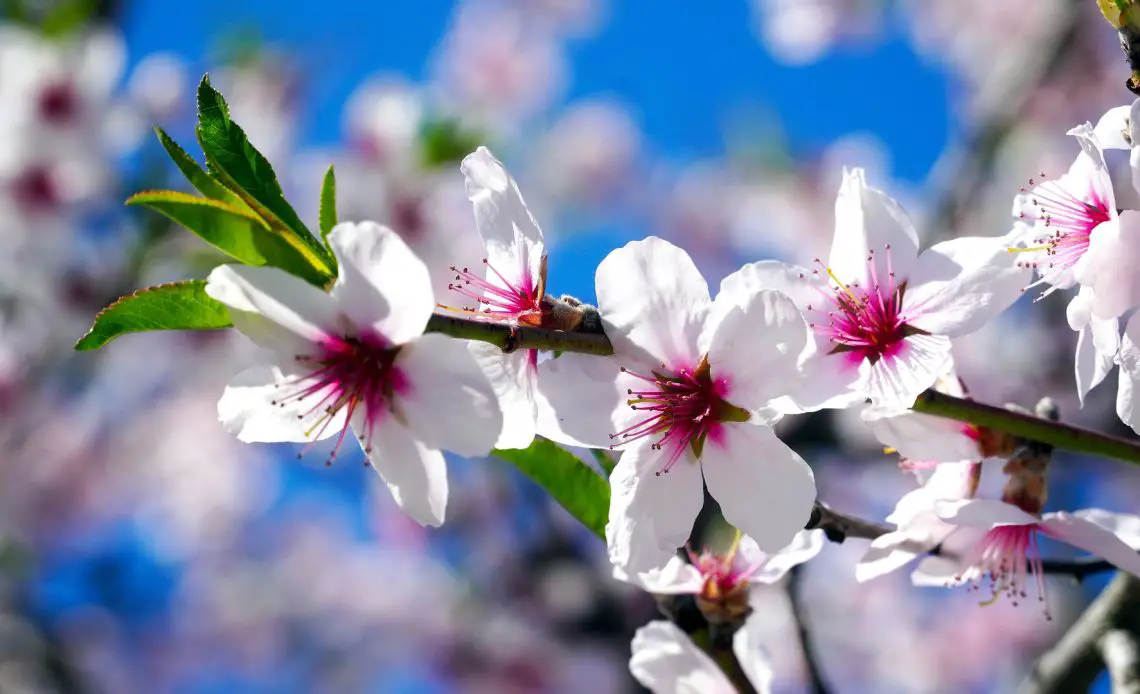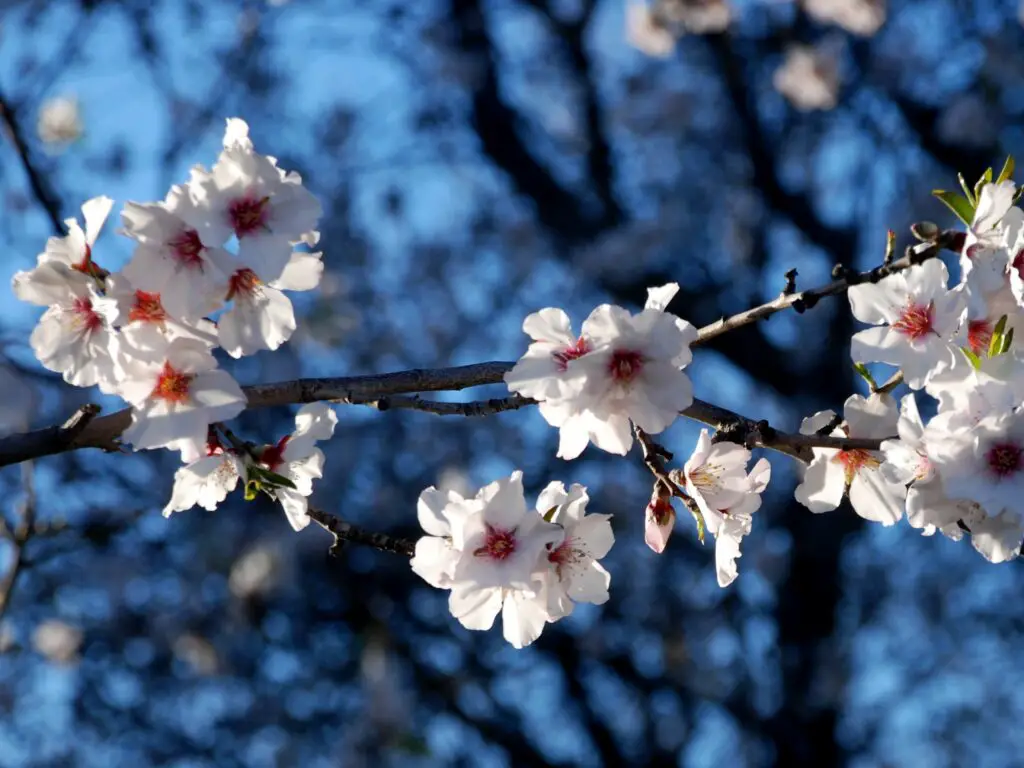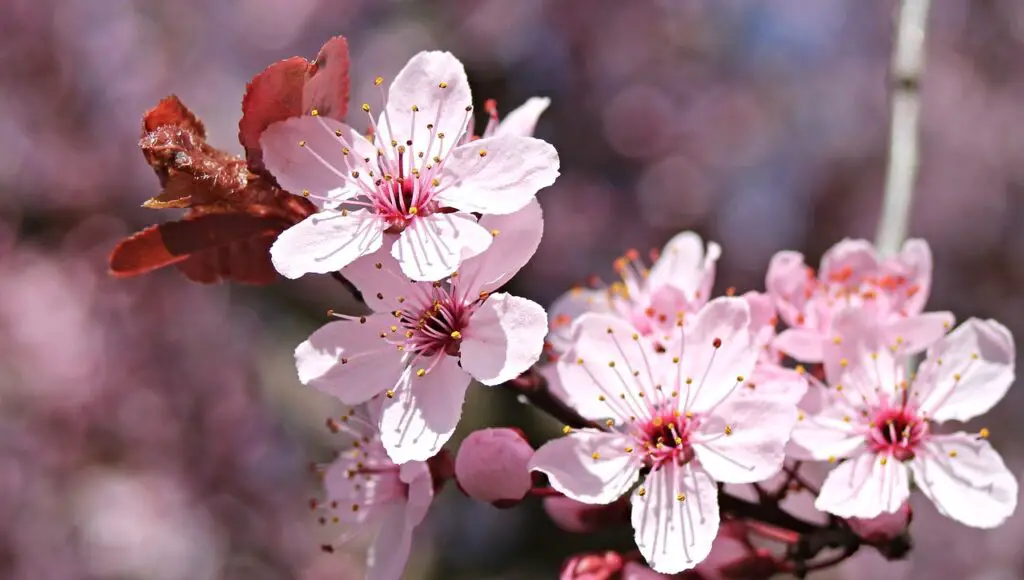
Last updated on May 20th, 2023 at 03:03 pm
The almond (Prunus amygdalus, syn. Prunus dulcis) is a flowering, small to a medium-sized deciduous tree in the rose family, Rosaceae. It belongs to the botanical genus Prunus.
The tree typically grows 3–5 meters tall and has an average lifespan of 20–25 years. It is the first deciduous nut tree to bloom in spring. The flowers are delicate, five-petalled, typically 3–5 cm in diameter, and their color ranges from white to pink.
Almond trees are drought resistant and can thrive even on poor soil. The scent of the almond blossoms is sweet and sometimes compared to that of jasmine and lily. The almond trees require a Mediterranean-like climate, with long, dry summers and milder, wet winters, to thrive well.
The almond is native to the Middle East—to Iran and several other countries in the region. Wild almonds were eaten even in the Neolithic period. In ancient times, it was cultivated and spread throughout the Mediterranean, southern Europe, and Northern Africa along the caravan trade routes. Traces of almonds have been found at Greece’s archeological sites, dating back to the eighth millennium B.C. It is estimated that the cultivation of almond trees in the Mediterranean region began around the third millennium B.C., in the early Bronze Age.
Today, almond trees can be seen across Europe, Asia, and North America, especially in California, which shares over 40 percent of the global almond market. The Spanish missionaries brought the almond tree to California In the 1700s.
The word ‘almond‘ is linked to the Middle English words ‘almond’ and ‘almaund,’ and to the Old French words ‘almande,’’amande’ and ‘alemondle.’ The origin of these words is traced back to the Ancient Greek word ‘amygdalos’ and the Latin word ‘amygdala.’ The exact origin and meaning of the word ‘almond’ are still unknown, although some theories speculate that ‘almond’ could be of Semitic origin.
Other theories hypothesize that, under the influence of the Spanish, the letter ‘l’ was erroneously inserted into the Medieval Latin word ‘amandus’ (meaning ‘lovable’) since many Arabic-origin words began with the article ‘al.’ Etymologically, the word ‘almond’ is also related to the German word ‘mandel,’ the Italian word ‘mandorlo,’ the Portuguese word ‘amêndoa’ and the Spanish word ‘almendro,’ all referring to the same tree.
What does the Almond flower symbolize?
The almond flower’s meaning is often connected to fertility and love. According to ‘The Dictionary of Plant Lore’ by D. C. Watts, people once believed that an almond tree that grew near a bride’s house would always be special. Such a tree would have a rich blossom and abundant fruits.
Similarly, in Indian weddings, people use almonds as fertility and abundance blessings. They believe that almonds bring money and children to the newlyweds’ families.
Ancient Romans, too, considered the blossoming almond sacred and auspicious. They used almond nuts as amulets for fertility.
The almond flower’s meaning includes bravery, courage, hope, and a new beginning since it is the first blossom to appear in the spring. It is the ‘Awakener’ flower.
The great Vincent van Gogh, in his painting Branches of an Almond Tree in Bloom, stressed this symbolism of the almond flower. With this painting, Vincent van Gogh celebrated a new life—the birth of his brother’s son.
The blossoming of an almond tree has similarly been an emblem of the Madonna, the Queen of Heaven.
In Islamic lore, the almond flowers are seen as a symbol of hope since they bloom on bare branches.
In Greek mythology, the almond flower meaning is everlasting love, which not even death can concur with. The story goes that Phyllis, the beautiful Queen of Thrace, became love-sick. She convinced herself that her beloved Demophoon, who had gone into the Trojan War, had fallen in love with someone else and would not return to her.
Her pain and despair were so deep that she committed suicide. After she died, the Gods metamorphosed her into an almond tree. But the Queen’s lover did return from the battlefield. As soon as he heard the terrible news, he ran toward the almond tree and embraced it.
Upon feeling the touch of Demophoon, the almond tree blossomed immediately, becoming a symbol of true, eternal love and faithfulness.
In the Bible, the almond wood rod in Aaron’s hand suddenly blossomed. According to another version of the story, the rod of Aaron was placed by Moses in the Tabernacle, and it miraculously blossomed during the night.
In both versions, the blossoming of the almond branch was perceived as an omen that Aaron would enter the priesthood. Because of this episode, the almond flower became a symbol of spiritual blessings, honor, divine favor, and approval.’
The almond blossom is beautiful and very delicate. Therefore, the almond flower means beauty, charm, delicacy, and sweetness. This symbolism is particularly strong in China. For the Chinese, the almond flowers symbolize feminine beauty and fortitude in sorrow.
All in all, the almond flowers symbolic meanings are:
- alertness
- delicacy
- charm and sweetness
- feminine beauty
- caution
- fortitude in sadness
- divine approval and favor
- virgin’s purity
- bravery and courage
- hope
- unending real love
- beginning
Meaning of the Almond flower colors
White Color

White almond flowers have 5 white petals and a pink center where you can see multiple stamens—where pollen is laid. These stamens surround a single pistil.
The color white means purity, honesty, and simplicity. This color evokes innocence, empowerment, goodness, and a beginning.
It also evokes the mood of creativity. That is why Van Gogh was motivated to make his live art based on these flowers.
In Ecclesiastes (12:5), the white almond flowers symbolize the passage of time and the transience of life. They symbolize old age—just before they fall, the white petals of the almond flower represent graying hair.
Pink Color

You can find pink and purple almond flowers in the central valley of California. During the almond season, there will be a beautiful display of a mixture of pink and purple almond flowers in the valley. It is a spectacular view indeed.
The color pink represents calmness, love, kindness, femininity, and vibrancy. This color is associated with love and romance. Feminine qualities such as softness, nurturance, and compassion are the feminine qualities of pink almond flowers. This flower color also induces emotions like joy and happiness.
In folklore, the pink almond flowers are often associated with weddings. It is said that these flowers are heaped at a traditional gypsy bride’s wedding in Spain. Namely, all the guests heap pink almond flowers over the head of the bride while she dances. Similarly, a wedding tradition in Greece includes pouring almond flowers over the bride’s head as a blessing.
Interesting facts about the Almond flower
- Almond flowers are botanically related to roses and orchids and are often called ‘the queen of the rose family.’
- The almond flowers are edible—they can be eaten raw and used as a garnish. They are sometimes added to complementary dishes, including marzipan, maraschino cherries, and ice cream. These flowers are also used as a decorative element in various cocktails.
- The almond flowers completely depend on wild bees and honey bees for pollination. Because of this, the farmers rent bees for pollination, which significantly increases the cost of almond production. The continued global decrease in the bee population is a high risk for almond producers.
- In an interesting study, scientists from the University of Haifa found that the nectar of the almond flower contains a toxic substance. This poison is not harmful to the bees, and the bees are particularly attracted to it.
- Flowering branches of the almond tree are carried into synagogues at the time of the Jewish holiday Tu B’Shevat, celebrating the arrival of spring.
- In a letter to his brother, Vincent van Gogh described his now-famous painting series, Almond Blossom, with obvious satisfaction. ‘It is perhaps the best, the most patiently worked thing I had done, painted with calm and greater firmness of touch,’ wrote van Gogh. Sadly, he finished the last painting of the blossoming almond tree just a few months before his death by suicide.
- These flowers inspired Dale Chihuly to make their glass sculptures because of their beauty.
- Almond flowers taste like nuts. These flowers have an aroma that is similar to lily and jasmine.
- Almond flowers have a natural component called Taxifolin. Well, Taxifolin has anti-carcinogenic properties.
- These flowers are very beautiful and are appreciated for their beauty.
How to grow Almond flowers
Almonds grow well in hot and dry climates where suitable irrigation is necessary. They need acidic soil, clay, and sand to grow properly; they do not grow well in wet soil. Loamy soil has a high concentration of organic materials that aid in tree growth.
- The almond tree should be planted in healthy soil with lots of freedom to spread out and develop upward in a safe area, away from frost traps.
- Plant during the dormant season, preferably in the fall. Keep it moist during dry periods and mulch it annually for the first year.
- Make space for two almond trees because some need a pollination partner.
How to care for Almond flowers
- Water them three times a week. But if it is raining, you should reduce the number of times you water them.
- Fertilizer with nitrogen in small amounts is good for increased flowering.
- Pruning aids in the production of almond flowers. After the flowers bloom fully, do light pruning for the right branching level.
Best time to gift Almond flowers
The almond flower’s meaning includes new beginnings, hope, and unending love. Therefore, almond flowers can be a delicate and thoughtful gift to couples during their engagement or wedding. In that context, selecting almond branches with pink blossoms is recommended. They can also be gifted to those who are celebrating their wedding anniversaries.
White almond flowers are more commonly associated with the fleetingness of time and the fragility of life, but they also have a strong spiritual symbolism. Therefore, one can consider gifting an almond branch with white blossoms to an older adult on their birthday or anniversary. This would be a celebration of their longevity and an act of honoring their knowledge, wisdom, and guidance.
Since almond flowers represent sweetness and delicacy, you can gift them to parents of born babies too.
Almond flowers bloom in early spring. So these flowers remind us of the earliest signs. So, it is ideal for gifting those who start a new life.
It also represents alertness; you can give them to a diligent student to compliment them for their alertness.
Conclusion
Almond trees are grown for extraordinarily beautiful flowers—almond flowers give a white and pink glow to the cold winter and promise the warm spring ahead. Almond blossoms look stunning and are mostly used for their visual appeal.
Overall the almond flower is a spectacular creation designed marvelously.
If you want to know and learn more about flowers, we at PansyMaiden can help you. Check out our fun, easy-to-read, and informative flower-related content that you will surely enjoy!
